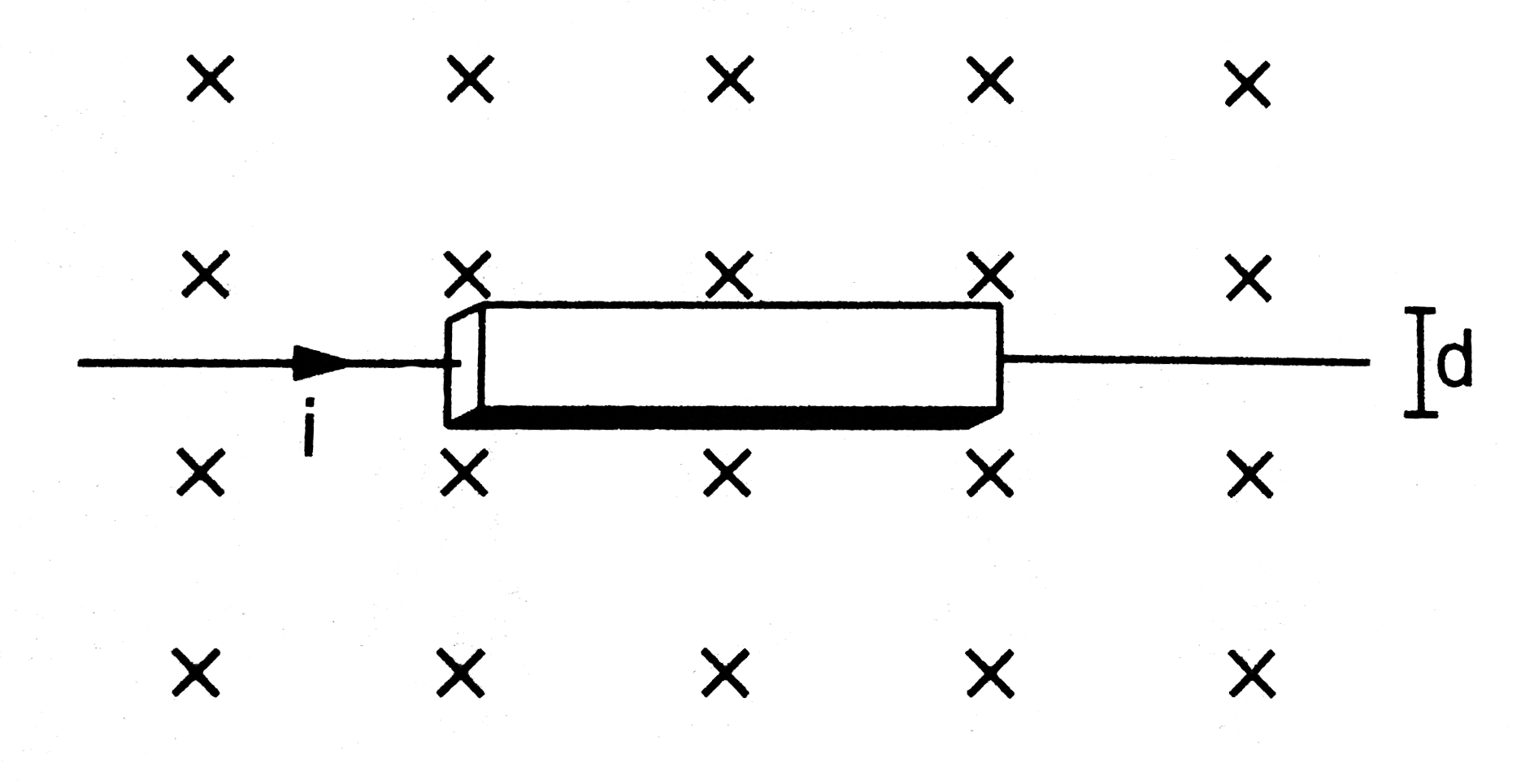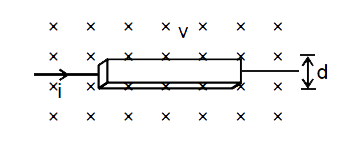A currrent I is passed through a silver strip of width d and area of cross section A. The number of free electrons per unit volume is n. (a) Find the drift velocity v of the electrons. (b) If a magnetic field B exists in the region as shown in what is the average magnetic force on the free electrons? (c) Due to the magnetic force, the free electrons get accumulated on one side of the conductor along its length. This produces a transverse electric field in the conductor which opposes the magnetic force on the electrons. Find the magnitude of the electric field which will be the potential diference developed across the width of the conductor due to the electron- accumulation? The appearance of a transverse emf, when a current-carrying wire is placed in a magnetic field, is called hall effect.

(a) i = V_(a)pi Ap <br>where V_(d) = drift velocity of electron,
n = number of electron.
Vd=1nAp
(b)F=p.(Vd×B)
=p.1nApB=iBAn
*( c ) Let the electric field = E .
eE=F=iBAn
orE=iBeAn
( d ) dV = Edr<br> V = (iBd) /(eAn) .
Topper's Solved these Questions
Similar Questions
If a charged particle at rest experiences no electromagnetic force, then electric field in that region
View SolutionFind the range of frequency of light that is visible to an average human being (400nm<λ<700nm)
View SolutionUsing the formulae ((→F)=(→qv)×(→B)and(B=(μ0)i2πr), show that the SI units of the magnetic field B and the permeability constant (μ0) may be written as (NmA−1) and (NA−2) respectively.
View SolutionA currrent I is passed through a silver strip of width d and area of cross section A. The number of free electrons per unit volume is n. (a) Find the drift velocity v of the electrons. (b) If a magnetic field B exists in the region as shown in what is the average magnetic force on the free electrons? (c) Due to the magnetic force, the free electrons get accumulated on one side of the conductor along its length. This produces a transverse electric field in the conductor which opposes the magnetic force on the electrons. Find the magnitude of the electric field which will be the potential diference developed across the width of the conductor due to the electron- accumulation? The appearance of a transverse emf, when a current-carrying wire is placed in a magnetic field, is called hall effect.

View SolutionAssertion: Free electron always keep on moving in a conductor even then no magnetic force act on them in magnetic field unless a current is passed through it. Reason: The average velocity of free electron is zero.
View SolutionA current of 16 A is made to pass through a conductor in which the number of density of free electrons is 4xx10^(28)m^(-3) and its area of cross section is 10^(-5)m^(2) . The average drift cross section is 10^(-5)m^(2) . The average drift velocity of free electrons in the conductor is
View SolutionIf A is the area of cross section of conductor, e be the charge on the electrons, n be the number of electrons per unit volume and J be the current density then drift velocity of electrons is
View SolutionIf A is the area of cross section of conductor, v_(d) is the drift velocity of electrons and n is the number of electrons per unit volume, then current density through conductor is
View SolutionIf n,e,A and v_(d) are free electron density inside conductor , charge of electron , area of cross-section of conductor and drift velocity of free electrons inside conductor, then current l through the conductor is
View SolutionIn a metallic conductor, the number of free electrons per unit volume is n and the drift velocity of those electrons is v_d . Then
View SolutionWhen a current of 1 A flows through a copper wire of cross sectional area 1mm^2 the drift velocity of free electrons becomes v, What will be the drift velocity of free electrons when the same current flows through a copper wire of cross sectional area 2mm^2 ?
View SolutionThe number of free electrons per unit volume in a metallic conductor is 1022cm−3.The area of cross section of the conductor is 1mm2 and the strength of current through the conductor is 1A. Determine the drift velocity of the free electrons,(Given that the charge of an electron −1.6×10−19C)
View SolutionThe length of a current-carrying cylindrical conductor is l, its area of cross-section is A, the number density of free electrons in it is n, and the drift velocity of electrons in it is v_d . The number of electrons passing through a particular cross-section of the conductor per unit time is given by:
View SolutionA current I is passed through a silver strip of width d and area of cross-section A. The number of free electrons per unit volume is n Find the drift velocity v of the electrons.
View SolutionA current I is passed through a silver strip of width d and area of cross-section A. The number of free electrons per unit volume is n If a magnetic field B exists in the region as shown in figure, what is the average magnetic force on the free electrons?
View SolutionA current I is passed through a silver strip of width d and area of cross-section A. The number of free electrons per unit volume is n

Due to the magnetic force, the free electrons get accumulated on one side of the conductor along its length. This produces a transverse electric field in the conductor which opposes the magnetic force on the electrons. Find the magnitude of the electric field which will stop further accumulation of electrons.
View Solution
